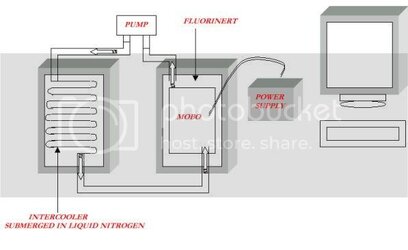Hey, I need plans for my future extreme liquid cooled computer. I was thinking you get another air conditioner to keep your parts lower than 20°C (68°F) off and if you can manage it on. The reason for this is to maximize conductivity of metals. You will have to modify your exhaust, use 1 small fan at a very low RPM at the highest point. Now I recommend you some 9x140mm or bigger radiators that will work with Fluorinert and you hook every part in your computer that generates any heat with homemade silver (or any metal with a higher thermal conductivity) waterblocks with very thin selenium (or anything with a lower thermal conductivity) heat guards wrapping them. This is so the waterblocks don't get heated by ambient temperature, but it also means your metals aren't at a 20°C from ambient temperature. To get around this you must liquid cool the heat guards or use a thin liquid cooled separate waterblock connected to main waterblocks made of something like aluminum, beryllium, copper, gold, magnesium, or anything lower than your main waterblock's thermal conductivity but not too low instead of a selenium heatguard. That part needs major expirimentation, I can't do it yet because I'm still building my PCs. Also make sure your waterblocks allow maximum flow, fitting 1/2in (very) thickwall tubing or better. And you can make the waterblocks based off brandname ones, I suggest Koolance or EK, made in a 3D editor, and printed with a 3D etcher or something of the sort.
Now the fun part (finally)
Get or make a high pressure air or CO2 pump (buy a giant empty propane tank and attempt to get it filled with CO2 ). Get the coldest variant of Fluorinert, a really good intercooler, and a substance like liquid nitrogen (somebody try pure oxygen at -218°C) to cool the Fluorinert without freezing it. Nitrogen may be too cold. If it does freeze add product like acetone, antifreeze, or WD40 and pump fine pulverized solid Fluorinert.
). Get the coldest variant of Fluorinert, a really good intercooler, and a substance like liquid nitrogen (somebody try pure oxygen at -218°C) to cool the Fluorinert without freezing it. Nitrogen may be too cold. If it does freeze add product like acetone, antifreeze, or WD40 and pump fine pulverized solid Fluorinert.
Set your liquid cooling up like this:

(this is an old pic from http://www.octools.com/fluorinert/ by OCTools Staff) instead of submerging your motherboard, simply set up normal liquid cooling (with your beast parts) but just after the pump insert your cooling tank and intercooler out side of your case.
This way I would think you could get an efficient, quiet if you are really good, and you don't need to change it every time your start up unlike DIce. Also this way you may be able to drop passed -183°C and superconduct multiple items in your motherboard, maybe it will get us 1THz without overclocking, it may be really bad and just break it or parts could repel and break solders and stuff.
I recommend you do this on junkers not your i7s. I really hope this works, if it does TELL US ABOUT THE SUPERCONDUCTIVE MOTHERBOARD! If not I hope it's a good way or breaks DIce.
I really hope this works, if it does TELL US ABOUT THE SUPERCONDUCTIVE MOTHERBOARD! If not I hope it's a good way or breaks DIce.
Now the fun part (finally)
Get or make a high pressure air or CO2 pump (buy a giant empty propane tank and attempt to get it filled with CO2
Set your liquid cooling up like this:

(this is an old pic from http://www.octools.com/fluorinert/ by OCTools Staff) instead of submerging your motherboard, simply set up normal liquid cooling (with your beast parts) but just after the pump insert your cooling tank and intercooler out side of your case.
This way I would think you could get an efficient, quiet if you are really good, and you don't need to change it every time your start up unlike DIce. Also this way you may be able to drop passed -183°C and superconduct multiple items in your motherboard, maybe it will get us 1THz without overclocking, it may be really bad and just break it or parts could repel and break solders and stuff.
I recommend you do this on junkers not your i7s.
